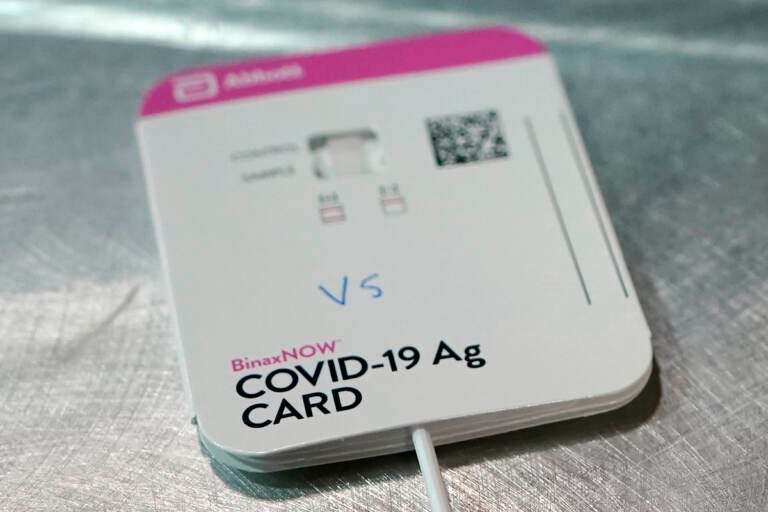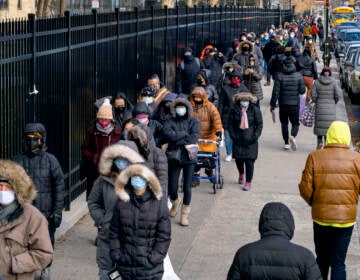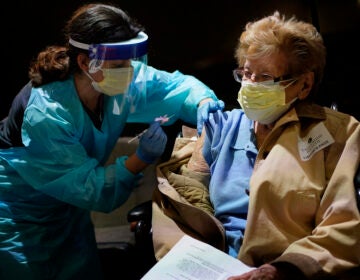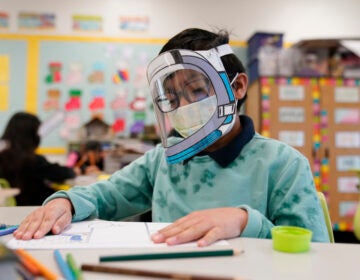How should we be using at-home rapid tests for omicron?
Recent research indicates these nasal swab tests may be less sensitive to the coronavirus’ omicron variant in the earliest days of infection.

A BinaxNOW rapid COVID-19 test made by Abbott Laboratories rests on a table on Feb. 3, 2021. (AP Photo/Ted S. Warren)
Right now, you’re lucky if you can find rapid antigen tests in stock at your local pharmacy. But the Biden administration is in the process of making 500 million of the at-home tests available for Americans to order, and local municipalities are working on securing them as well.
Health experts and elected officials alike are signaling the tests are a key tool in the fight against the latest massive omicron wave of the pandemic.
But recent research indicates these nasal swab tests may be less sensitive to the coronavirus’ omicron variant in the earliest days of infection, and the Food and Drug Administration has issued a warning noting as much. Still, experts say rapid antigen tests do work to detect omicron and can be used as a means of reducing its spread. We just have to know how and when to use them.
I have COVID symptoms. What kind of test should I take?
At-home rapid antigen tests such as BinaxNow or QuickVue measure the viral proteins in SARS-Cov-2 that increase as the virus replicates in the body. Because of that, rapid tests only pick up an infection when the virus is making more of itself. Luckily, that period of time coincides pretty closely with the time when a person is most contagious.
“The rapid tests really do pick up when you are most infectious to other people,” said John Wherry, director of the Institute for Immunology at the University of Pennsylvania Perelman School of Medicine.
On the other hand, PCR (polymerase chain reaction) tests — which take longer to process in the lab, sometimes many days — are looking for any trace of the virus itself. That means they might be able to detect infection earlier on in the illness. But it also means PCR’s can continue to detect trace amounts long after a person has stopped being contagious.
So if you recently developed symptoms or were exposed to someone with COVID-19, a more sensitive PCR test might be better able to detect the virus initially. But given the limited appointment availability and wait time for many PCR results, you might be better off just taking a rapid test at home.
I have symptoms but got a negative result on a rapid test. What’s going on?
Rapid tests, conducted by nasal swabs, are able to pick up infections caused by the coronavirus’ delta variant quite reliably when people have symptoms. With omicron though, there have been numerous reports of people testing negative during the first few days after exposure, even when they have symptoms. A recent study demonstrated that among a small group of people infected with omicron, there was a two-day lag time between a positive PCR result and a positive antigen test result.
The study also found that saliva may be a better indicator of the virus sooner than nasal swabs were, regardless of the kind of test.
Experts speculate that the lag is most likely explained not by the omicron variant somehow evading the tests, but instead because of where it replicates. While delta is more likely to show up first in the nasal cavity, omicron replicates first in the throat or upper trachea (which is also why one of the most common symptoms is a sore throat.)
This hypothesis has led many experts to promote the idea of using the nasal swabs included in the rapid test kits on the back of your throat, to pick up a saliva sample. Anecdotally, results have shown that when taken at the same time, throat swabs can produce positive results while nose samples come back negative. Though this technique is not authorized by the FDA, it is standard in the U.K. and parts of Europe.
If you think you have COVID-19 and your rapid nasal swab comes back negative, you could try swabbing your throat. Basic guidance is to drink a glass of water, not eat or drink for 30 minutes, swab your throat, and then swab your nose with the same test stick. There are step-by-step instruction videos on various U.K. government websites. The FDA has cautioned that the technique is not authorized and can be done incorrectly. Experts say more data is needed but the anecdotes are promising.
“If it turns out that a saliva test is the way to go, or if a throat swab is the way to go, then we need to figure that out,” said Gigi Gronvall, an immunologist and senior scholar at the Johns Hopkins Center for Health Security who is tracking the development and marketing of various types of COVID tests throughout the pandemic.
What if I’m not into the whole throat thing?
If you have symptoms but tested negative, it’s best to try taking another rapid test the next day — if you can get your hands on more. Because a person’s viral load can increase extremely quickly, rapid antigen tests are best when used sequentially, or repeatedly over the course of a couple days. If you do decide to wait and try again, it’s probably best to act as if you have COVID-19 in the interim between tests and stay away from others.
“If you don’t test positive when you first take a test, that might not be the get-out-of-jail-free card that you’d like it to be,” said Gronvall.
You could also try for a PCR test, which is more sensitive than a rapid test. But appointments are hard to come by these days, and results take a while to come back, so that may not be the most realistically helpful option at this stage.
The bottom line: With the amount of virus circulating right now, COVID-like symptoms are probably COVID, and it’s safest to assume as much.
“If you’re symptomatic, I might really question more now than I did previously what a negative rapid antigen means and whether or not, you know, I really need to do the thing I’m going to do,” said Kelly Wroblewski, director of infectious disease programs at the Association of Public Health Laboratories.
I was exposed to COVID but don’t have symptoms. Should I still take a rapid test?
Yes, but it’s worth waiting a few days. If you take a test right after your known exposure, you likely won’t have enough viral load to register on a test — or to be super infectious to others. Three to five days is about the right timing, said Wherry, and if you can take a few tests in a row, that’s best, in case you’re too early. If your results continue to be negative and you don’t have symptoms, you can trust that your vaccine and/or your booster are working.
I had symptoms and took a rapid test and the results were negative. A few days later, I took another rapid test, and it came back positive. Have I been exposing everyone over the past couple days?
The short, unsatisfying answer is that we need more data on this. It’s likely that people are less contagious during the period before the rapid test picked up your illness than at the point it registered positive. But it’s not impossible you could have infected others.
“Is it possible that people are spreading the virus before the virus moves into their nasal passage in terms of growing there at a concentration high enough to be detected? Yes,” said Michael Mina, formerly of Harvard’s T. H. Chan School of Public Health, now chief science officer at eMed, an at-home testing company. “Do I think they’re at peak infectiousness at that period of time? No.”
The small study mentioned earlier found that among those with false negative antigen tests, four people did transmit the virus to others in the period between their tests.
If you have symptoms, got a negative test, and absolutely need to leave the house for work or other necessary tasks, the key is to layer protections: wear an N95 mask, and avoid vulnerable populations.
What about on the back end of my illness? Does a negative rapid test mean I am no longer contagious?
Probably. That’s why so many experts, with Mina at the helm, advocated for the Centers for Disease Control and Prevention to add a testing component to its new isolation guidance. They argued that because the rapid tests are a good measure of when a person is infectious, two sequential negative rapid test results would be a safe way to signal people could leave isolation. Instead, the CDC said people who never had symptoms or whose symptoms had subsided could leave isolation after five days, with an additional five days of masking. Mina and others cautioned it’s very likely that people who tested positive five days ago are still infectious — especially now that symptoms are coming on before people are at peak viral load.
“Before, the symptoms started when you were at peak viral load, so five days made a lot of sense post-symptom onset,” said Mina. “Now, symptoms are coming on days earlier, so five days into symptoms might be your peak virus at that point.”
While testing out of isolation may be an ideal solution, Gronvall said it’s not necessarily a practical one until the testing infrastructure is bolstered.
“Everybody has access to a calendar. Not everybody has access to tests,” she said. “And so that is a good reason to have a simple policy that’s just relying on that calendar.”
The CDC did add to its guidance a recommendation to test if tests are available.
I’ve been using rapid tests before gatherings to make sure I don’t have COVID and won’t infect others. Is that still safe to do?
The best way to think about rapid antigen tests is as a screening tool to reduce transmission — not to completely eliminate it.
“None of our measures of protecting ourselves or prevention are perfect,” said Wherry. “Vaccines aren’t perfect. Masks aren’t perfect. Tests aren’t perfect. But when used in combinations and in layers, we can dramatically reduce risk.”
In other words, they’re better than nothing.
So yes, if you’re going to have a gathering, it’s better to take a test than not. If you have to go to work, it’s better to take a test before. And because the tests are capturing your infection level at a very specific point in time, the closer to the event you test, the better.
“You want to make sure that if you’re having dinner at 6 with friends and you’re using these tests to be able to safely get together or at least reduce your risks, take the test right before, not the morning of,” said Gronvall.
That said: If you can work remotely or postpone the gathering, the experts agreed, that might be better while so much highly contagious virus is circulating.
This is so complicated! Will testing ever get simpler or more streamlined?
Gronvall acknowledged that testing is confusing, and that this latest round of complications adds to the overall sense of uncertainty. But as our understanding of the virus evolves to a point where we can provide accurate testing, a new variant pops up. So, she said, while we can expect the state of testing to improve over the next months and years, we unfortunately should expect it to keep changing, too.
Wroblewski said federal agencies are looking into saliva or other oral swab collection methods for antigen tests, but the conversation is moving slowly. Gronvall agreed that as long as the scientific landscape keeps evolving and changing, testing will have to as well.
“I think this kind of confusion is not going to go away anytime soon,” she said.

Saturdays just got more interesting.
WHYY is your source for fact-based, in-depth journalism and information. As a nonprofit organization, we rely on financial support from readers like you. Please give today.




![CoronavirusPandemic_1024x512[1]](https://whyy.org/wp-content/uploads/2020/03/CoronavirusPandemic_1024x5121-300x150.jpg)



